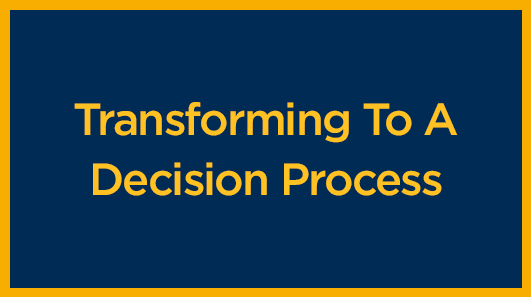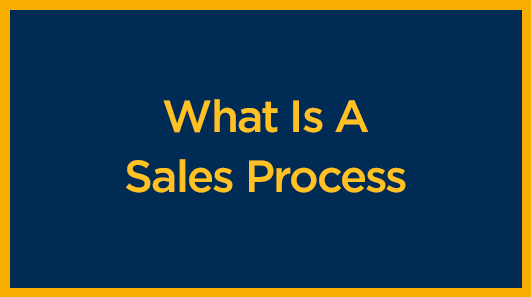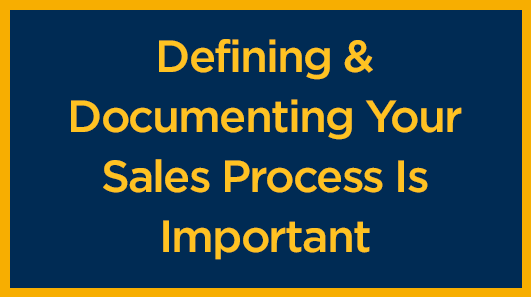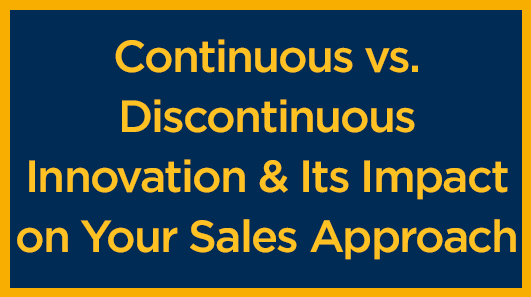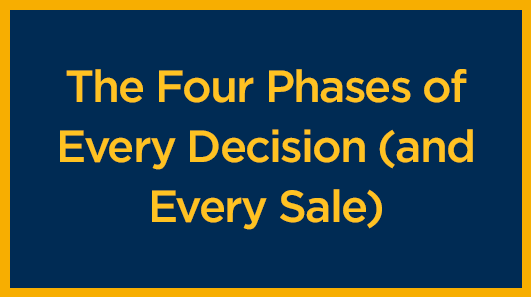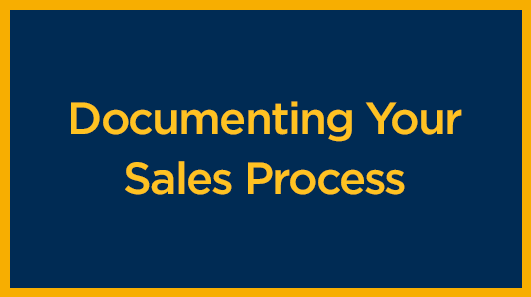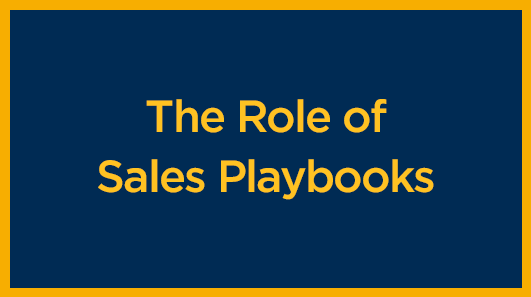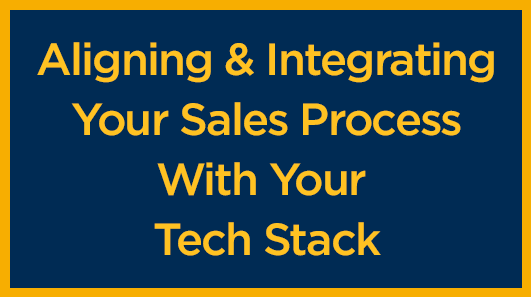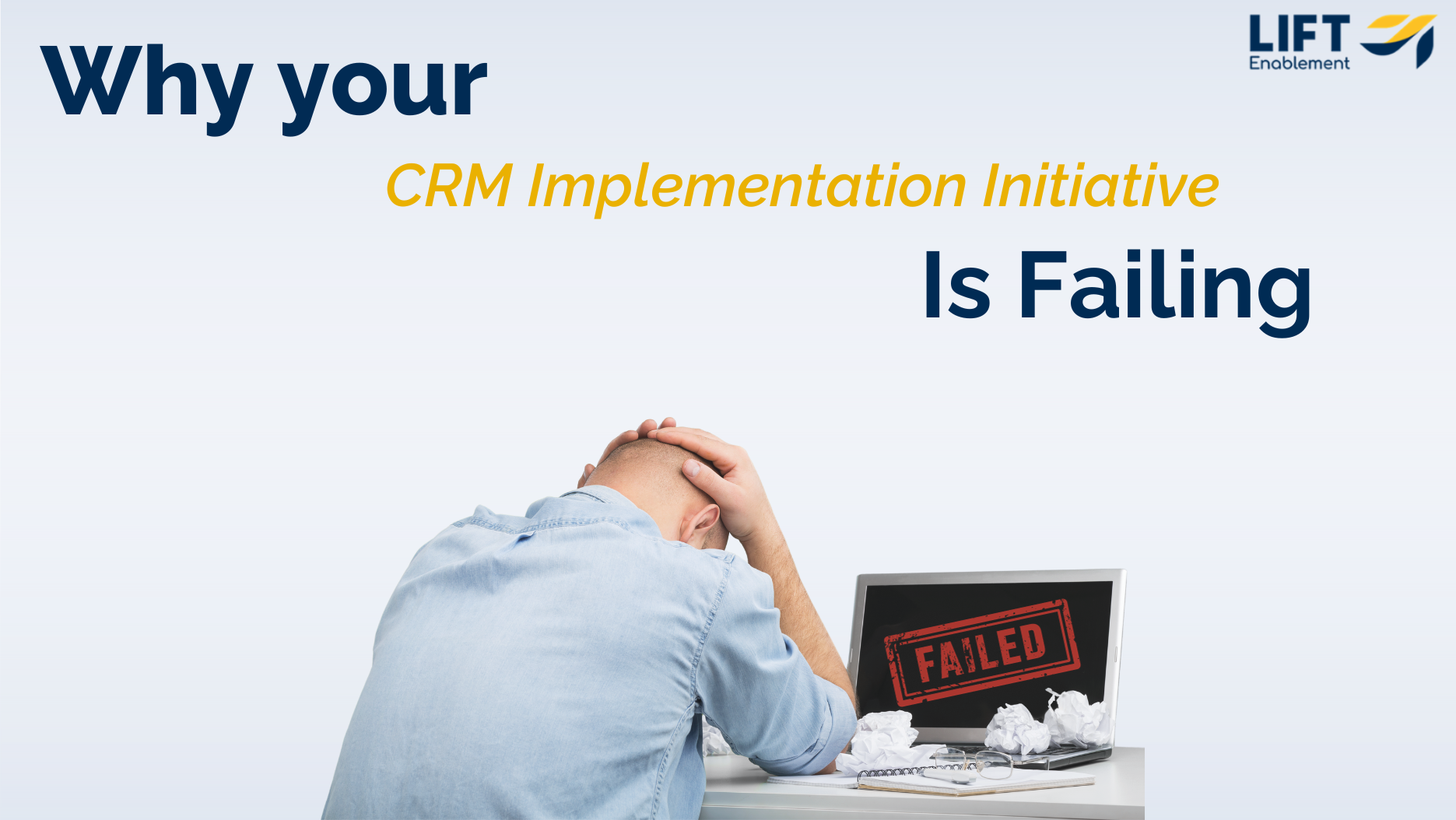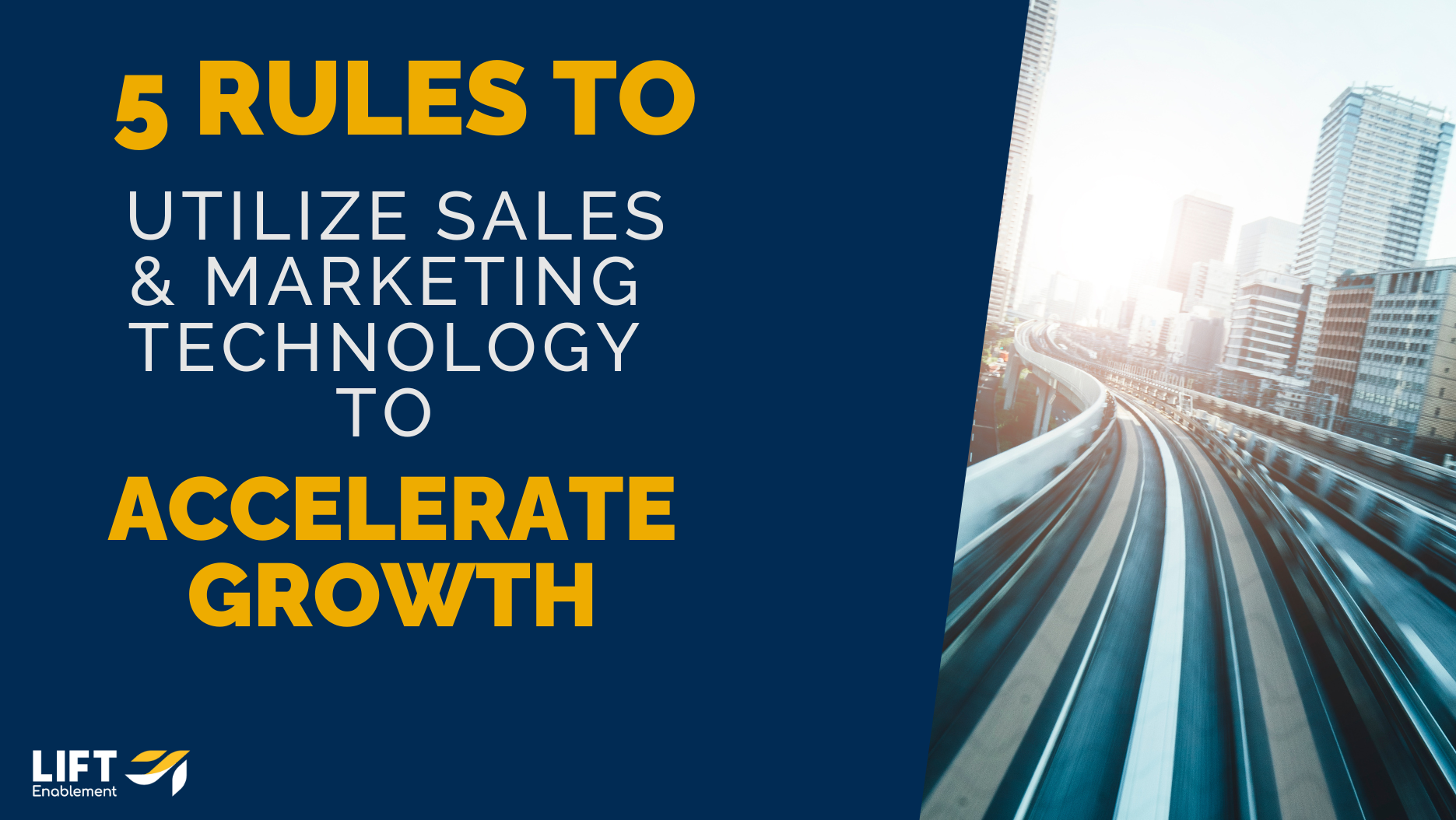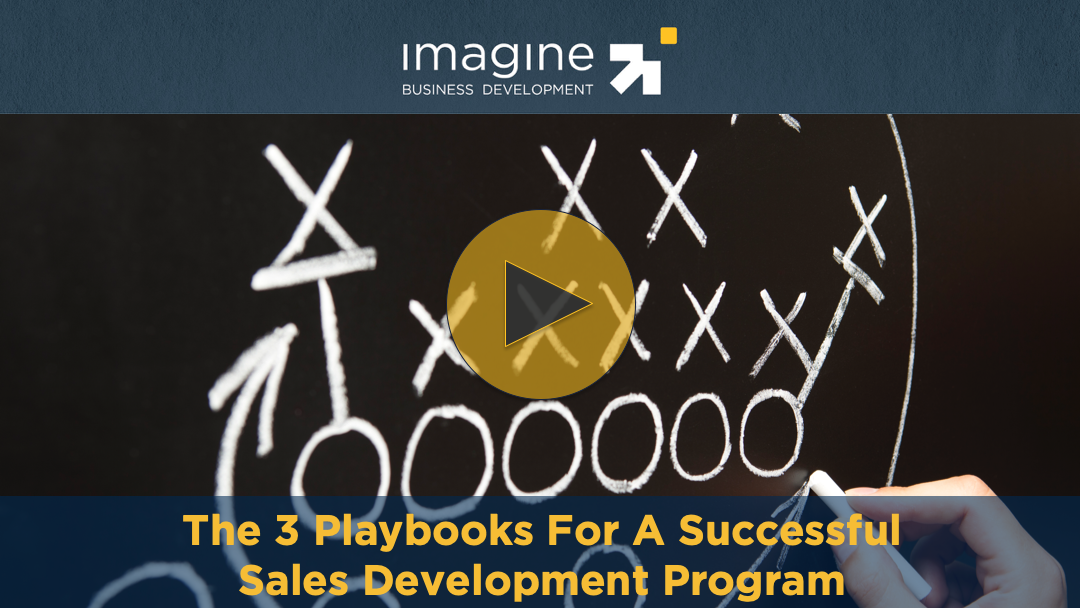The Comprehensive Guide to Designing a High-Impact Sales Process
Selling is an important business discipline. Your sales approach is likely to be the first, and most important, connection with your market. While there are some unique attributes associated with the sales function, it should not be treated any differently than any other business process.
Engineering your sales, or customer acquisition, process requires that you understand the two aspects that make selling unique:
- Selling is an open-loop system (meaning your organization only controls a portion of the sales process, the customer controls a significant portion as well) whereas most other business processes are closed-loop.
- Every selling interaction is a unique and dynamic process. Therefore, your approach to managing it must be dynamic as well.
Over the last 30 years, we’ve worked directly with thousands of organizations and studied thousands more. This guide is designed to ensure your sales process is well designed and high impact.
The Decision Process
What is selling? Think about that question for a moment. We think about that question a lot. We define selling as: the professional process that enables two or more parties to reach a mutually beneficial result.
There are three key components to this definition.
- Selling is a process. It is a series of actions, not just one act.
- The process results in something that mutually benefits the parties involved. It’s win-win or there is no deal.
- The process is professional, meaning that it conforms to some standard. This doesn’t mean that there is no room for individuality or creativity, but rather that there is discipline to the process.

The Problem With Traditional (Old-School) Selling
Tom Hopkins, Brian Tracy and Zig Ziglar (as well as other advocates of “old school” sales) often talk about the seven or so steps involved in the selling process. Because most of these processes are designed from the seller’s point of view only, they do not deal effectively with the level of sophistication that exists in today’s buyers. Consequently, the value of these selling processes is quite limited and often creates more negative effects than positive.
As information became ubiquitous in the era that Alvin Toffler refers to as the Third Wave, the interest in many traditional selling processes diminished. New schools of selling emerged. One flipped the old-school thinking on its head by advocating a buying process that aligns points of the sale with the considerations a buyer makes. Neil Rackham’s SPIN SELLING program and Miller Heiman and Michael Bosworth’s Solution Selling all represent this school. While these approaches were certainly a step in the right direction, they still suffer from the same core problem.
The problem? All of these approaches are designed to solve for making a sale. What’s wrong with that? Selling is or should be, focused on enabling people to make smart decisions that are mutually beneficial. Instead of solving for a sale, powerful selling solves for making a quality decision.
By focusing on the decision process, buyers and sellers are empowered to become creators, instead of just value communicators (or, even worse, value extractors).
Traditional sales methods have a binary view of their market; you’re either a customer or a prospect. Little to no delineation is made between a prospect who has not yet begun their purchasing journey to one who is in the embryonic stage and those nearing a final decision. To quote one very famous sales trainer, “If you’re qualified, you either buy or you die.” The legacy process also pays no attention to the quality or fit of the prospect/customer. This results in a lack of transparency and line of sight, which is a major reason sales forecasting is so inconsistent and inaccurate.
To remedy this, many sales departments have added some form of a gate system to their pipeline process. These gates categorize prospects according to where they are in the “selling” process or the “buying” process. While these gate systems offer an improvement over binary systems, they still lack the effective structure needed to salespeople, their managers, and the executives in charge of growth, the knowledge and insight they need to make good decisions and to utilize their time efficiently.
The traditional focus on closing sales, or even on “enabling people to buy,” creates an inherently adversarial relationship. In contrast, this approach puts the salesperson in a leadership role and creates mutual benefit. The rep moves from “selling” to facilitating the completion of often-complex decisions. Both the seller and prospect move forward with more clarity, confident in knowing where they are in relation to the overall process and knowing what the next, right action should be.
Shifting to a focus on managing decisions is far more than just changing the words you use to describe things; it’s a paradigm shift. It means viewing the sale from both the buyers’ and the sellers’ perspectives. It means managing the sales cycle in a disciplined manner. A focus on leading your prospects and customers through a defined decision process creates value for both the buyer and the seller.
Imagine...
- Knowing precisely what steps need to be taken to advance a sale
- You and your buyer communicating clearly with each other, and each of you working to help the other improve best results
- Your customers and prospects helping you make sales
Addressing Decision Reluctance
When a buyer (or their organization) must change to fully take advantage of your offering, the context of the decision they must make changes markedly. In simpler sales, the decision is a fairly simple computation: if the value of the offer is greater than the cost, and it fits a need; the decision to move forward is embraced.
However, with discontinuous innovation, the buyer’s assessment of their ability to make the changes necessary and the various costs and risks (can you say “unexpected consequences?”) associated with those changes becomes even more important than the perceived value or need of whatever is being offered. If you are not proactively and directly influencing and supporting this part of your prospect’s decision process, then your chances for predictable, consistent sales outcomes are nearly zero.
Consider this. There are only four reasons a prospect does not buy from you:
- They do not need what you are selling.
- They do not trust you.
- They perceive that the pain (or cost) of making the changes necessary are greater than the pain (or cost) of not making them. This boils down to they don’t view the consequences of not buying from you to be significant enough to justify buying from you.
- They suffer from decision reluctance, unable to make a decision because they do not feel they have adequate information that is necessary to make a buy/no-buy decision. By the way, this often happens even when they do have the information, but the manner in which the information was gathered was haphazard.
Shifting the focus from “managing a sale” to “managing a decision process,” can ensure that you don’t lose the sales you should win, while giving you a clear signal earlier in your efforts about those sales you’re unlikely to win. This enables you to free those resources to apply to better opportunities (even if that means generating new ones). For example, one of the early decisions customers make is determining that they do, indeed, have a concern or a problem.
What Salespeople Are Doing Wrong
A common mistake made by salespeople at this point is that they assume that because a customer states they have a problem, they also understand what it will take to solve the problem, and they want to solve it. They respond as though the only decision left to make is to determine who the best vendor is. Based on these assumptions, the salesperson goes full bore, talking to the customer about all of the wonderful things the salesperson’s company can do to help them solve the problem.
The presentation is often eloquent, and the salesperson is complimented on their professionalism and the quality of the presentation. Sometimes the customer even follows up with questions or concerns. The salesperson and the sales manager typically view this as a positive indication that the customer is about to make the decision to buy, and move the opportunity into a forecasted status.
However, the customer has failed to answer for herself several key questions:
- How much does this problem cost me?
- Where does the problem rank when compared to my other problems?
- What will the pay-off be in implementing the solution?
- What are the risks associated with the solution?
- What are the alternatives?
The list goes on.
Enter decision reluctance. Decision reluctance occurs when little to none of the information provided by the salesperson is related to the particular decision that the customer is attempting to make. Realize, the customer may be unaware that she lacks the necessary information to make a decision.
What Is A Sales Process
A sales process is the documented representation of the repeatable steps a sales organization intentionally follows to acquire customers, and, when appropriate, deepens and expands the products, services and/or solutions that they provide to their customers/clients.
A strong sales process will have the following elements:
- Aligns with the customer - Sales don’t occur in a vacuum. A strong sales process aligns with the context of the buyer’s world and is aligned with their journey and situations. It’s for this reason that no two (good) sales processes are identical.
- Clearly defined waypoints and exit criteria - A sales process is to a selling organization what naval maps are to a sailor. A strong sales process identifies the critical milestones and contributors to a successful outcome. It brings clarity to a world of ambiguity.
- Flexible & Dynamic - While a strong sales process is focused on critical milestones, it’s flexible in how any individual sale is managed and achieves those milestones, allowing the natural differences among salespeople, customers, and situations to be managed naturally.
- Repeatable - A strong sales process creates a model for reps to manage opportunities in a repeatable fashion.
- Supports non-linear interactions - The purchasing journey is not a straight line. Buyers enter with different perspectives and at differing points. Information necessary to manage a sale can be uncovered at virtually any time in the process. Therefore, a strong sales process is built to leverage this reality into a strength.
- Solves for decisions, not sales - A strong sales process moves beyond managing a sale and instead works to enable the buyer and seller to make a strong decision.
- Progressive - As a sales opportunity moves through the milestones of the defined process, it should measurably advance the journey towards its conclusion.
- Designed for win/win outcomes - The goal of any strong sales process should result in a situation where the buyer wins and the seller wins.
The Difference Between Sales Process & Sales Methodology
While these two terms are closely related, they describe distinctly different elements. A sales process is a clearly articulated, linear description of the repeatable set of steps that are followed, while your sales methodology represents that modus operandi (MO), approach or set of rules, activities, and deliverables that are used to progress through the sales process.
A strong sales process provides enough flexibility to account for the contextual differences that are at play in any sales organization and, when combined with a strong sales methodology, reinforces the discipline to create greater predictability and control in the outputs/results.
Why Defining & Documenting Your Sales Process Is Important
There’s an old adage that goes “If you don’t have a plan, you don’t have a chance; and if the plan isn’t in writing, you don’t have a plan.” The same can be said about your sales process.
Before addressing the importance of defining and documenting your sales process, let’s take a step back and establish a clear purpose for the process. A sales process is like any other business process. There are three objectives for any meaningful business process:
- Make the business more efficient without sacrificing the impact of what is being done.
- Create consistency among (or standardize) the various activities that a business does, enabling it to effectively manage the complexities associated with growth, or to be able to scale the business.
- Establish the base to enable continuous improvement or optimization and to be able to prudently make adjustments as situations change.
Realize that regardless of whether your sales process is documented, you have a sales process. The problem with a sales process that is not fully documented is that, with the nature of sales, you (and your team) never do the same thing twice. With no documented process there is no standard to guide, assess, or optimize the actions that you are taking, and that means greater disruption & complexity, slower sales velocity, and higher costs.
Continuous vs. Discontinuous Innovation & Its Impact on Your Sales Approach
Much of the conversation around effective sales strategies focuses on the differences between B2B vs. B2C, products vs. services, and high price vs. low price, but the most important difference is whether you’re focused on selling a continuous vs. discontinuous value proposition.
The difference between the two is the level of change required on the part of the buyer (and/or the buyer’s organization) to capture the benefits and desired outcomes that lead to the purchase.
With continuous innovation, little to no change is required. The day after the purchase, the buyer continues behaving in the same way they did before and the benefits/objectives of the purchase are realized. For example, if a company were to change the supplier for office products, there is likely to be very little change required to benefit from the new supplier.
Discontinuous innovation, however, requires a significant amount of change on the part of the buyer to realize benefits. Say a company is looking to eliminate the friction from their marketing process and consequently begins a search for a new marketing automation product. In addition to learning the new product’s interface, they will also have to do things differently to ultimately realize their desired outcomes.
 Most companies that provide value-added services require some form of change on the part of the buyer in order for the buyer to benefit from the solution. Your product, service, solution (or whatever it is you call it) requires this type of behavioral change if it:
Most companies that provide value-added services require some form of change on the part of the buyer in order for the buyer to benefit from the solution. Your product, service, solution (or whatever it is you call it) requires this type of behavioral change if it:
- Represents a new system (technology or otherwise)
- Requires training of some sort
- Requires the buyer to see or understand a “new approach”
- Involves a “ramp-up” time for the buyer to experience results
To determine if you provide discontinuous innovation, ask yourself:
Can my customers and potential customers fully benefit from my solution if they do not change aspects of their behavior?
If you answer ‘yes,’ you are probably providing continuous innovation. But if you answer ‘no,’ then your sales approach must be aligned with the buyer of discontinuous innovation.
There is a relatively low risk when purchasing continuous innovation. Discontinuous innovation, though, involves risk on the buyer’s part. Buying a value-added solution involves risk. Among other risks, buyers risk:
- their financial investments
- the time they put into implementing the solution
- looking bad to their company or their colleagues
- the possibility that your solution won’t work for them
The buyer (and/or the buyer’s organization) may fail to make the change necessary to gain the benefits of the solution. Additionally, because of the change required, the buyer doesn’t have any experience that indicates the solution will even solve the problem. The decision to buy your solution should be driven by a buyer’s understanding of his/her problems – not by a buyer’s understanding of your company’s features and benefits.
The Four Phases of Every Decision (and Every Sale)
In order to develop a decision process for your company, you must identify and document the many decisions your customers and clients consider when choosing to buy your products or services. Furthermore, you must list those decisions in the order your customers follow when they make decisions. Both of these are critical.
It is important to understand that when the decision to buy occurs, it actually represents the culmination of many decisions made along the way. (Don’t confuse this with the old school “momentum close” technique.) While it is impossible (or, at least, close to impossible) to outline every decision a buyer goes through across all industry types, every decision someone makes goes through four distinct phases. (Note: this refers to the organization, not to the buyer role.) These four phases apply to every decision, no matter how big or small, in some cases these four phases are completed in seconds, in other cases, it could take years or anywhere in between.
The Discovery Phase
The Discovery Phase encompasses everything a prospect does before entering the first phase of intent (the intent to investigate). Much of The Discovery Phase occurs without the prospect/customer even knowing they’re thinking about it - that’s why we call it The Epiphany Phase in the buyer’s journey.
In this phase, the prospect is prioritizing what’s important, becomes aware of issues, obstacles, and opportunities affecting their business and ultimately where their attention is going to focus.
The Discovery Phase is also where the buyer and seller first meet. It’s crucial that marketing and sales activities are well-orchestrated and in alignment with the overall approach your company is taking. Discovery is particularly important because it is when the prospect is most open to influence. Most of the discovery phase occurs “beneath the surface” because there is no active consideration taking place, but what happens here will disproportionately impact everything that happens afterward.
The Diagnosis Phase
While The Discovery Phase generates awareness, demand is generated and the decision criteria are developed in The Diagnosis Phase. In this phase, the prospect moves beyond the general feeling of a problem and begins to define the problem, its cause, and its priority.
At this phase of a decision, it’s easy to get confused with a focus on defining various solutions and what those solutions represent. However, those sellers (and sales organizations) that build a strong diagnostic skill and toolset have the opportunity to quickly separate themselves from the competition and gain a competitive advantage.

Realize that the number one indicator into what someone, or an organization, will ultimately do (and buy) is based on how they define the problem, its cause, and its cost. For this reason, we teach that “The sale is made in diagnosis.” What’s more, when a sale gets bogged down or when a buyer behaves in a non-predictable manner the genesis of that is almost always because of what happened (or didn’t) in this phase.
The bottom line: Don’t skip steps in diagnosis.
The Design Phase
Attention moves to figuring out the best way to solve the problem in this phase. Realize that if the problem is not clearly defined in The Diagnosis Phase, it’s going to be very hard to define a clear, better solution in The Design Phase.
While decision criteria are first defined in The Diagnosis Phase, they are refined in The Design Phase. In this phase, the buyer is seeking to understand the various solution alternatives that are possible or available. They’re considering the resources they can put towards the problem and are seeking to understand and navigate the trade-offs inherent in the various options (which it should be noted - continue to include doing nothing or simply sticking with the status quo). This is also the time where, if the buying organization hasn’t done so already, it should define how they will make and implement the decision they ultimately make.
A common mistake in this phase is when the seller becomes overly directive and doesn’t involve the prospect’s organization in the process. The Design Phase is most effective when it is done collaboratively and the prospect is involved in understanding the various alternatives, risks, and trade-offs. The more involved the buyer is in the process, the more the “solution becomes their own,” and the seller maintains a facilitating leadership role in the process.
The Decision Phase
In traditional selling, this is the phase that gets all of the attention. This is the time when the seller puts forth the “Kodak moments” presentation.
When you move to view the sale through the lens of facilitating a mutually beneficial decision, this phase becomes the simplest. Through Discovery and Diagnosis, the buyer and seller have become clear on specifically what the problem is, the cause of the problem, its cost and just how important addressing it is. The Design Phase brings clarity to what needs to happen to achieve the prospect’s desired expectations and what red flags exist. The presentation merely needs to demonstrate that it meets the items that have already been articulated to this point.
Defining & Documenting Your Sales Process
An effective sales, or decision, process requires both parties (seller and buyer) to be fully engaged and active. Two flaws with the implementation of traditional selling approaches are that a) only the buyer is making the decision (the seller sells and the buyer decides yes/no) and b) the approach sets things up with one big decision (yes/no) and any other decisions are subservient to the yes/no decision.
In a modern decision process, both parties are responsible for making a series of mutual decisions that build upon each other, so that there is no one decision that is disproportionately bigger, more important or riskier than another.
A strong decision process is built on two key principles:
- The only thing worse than losing a sale you should have won is winning a sale you should have lost. The goal, as stated earlier, is win-win or no deal.
- Successful sales today are time-intensive, so identifying prospects who do not represent strong probabilities is crucial so that you can allocate the time that would have been spent on those pursuits to higher-value, higher probability opportunities.
Ensuring that your sales organization takes this type of approach successfully requires that you fully define and document your decision/sales process. The documentation of such a process is not only important for new sales reps, or those who are struggling. It is required for the best sales organizations (if they’re going to be the best).
The reason documentation is so important is the very reason that so few organizations actually document it. Successful selling today is dynamic, complex, and requires an orchestrated, aligned experience across multiple touchpoints, from multiple people over an extended period of time. With so many variables, the lack of documentation makes it impossible to create an aligned experience and to both generate the force required while eliminating the negative friction that drags down results.
Here’s where things can get tricky. The most common mistake made when documenting your sales process is to over-engineer it. Your documentation must align with how things are done in “the real world.” This means that you want enough detail so that the roadmap to the sale is clear, but not so much that the process becomes rigid.
When designing your sales process you’ll want to identify the waypoints that represent key inflection points along the sales process. We recommend that each waypoint you define (typically 5 - 8) becomes your deal/pipeline stages.
Next, you’ll want to group the actions you’ll take together as you progress through the decision/sales process. As you do this, you’ll see that they break into two categories:
- Those activities/actions/decisions that happen (or should happen) in a defined progression.
- Those activities/actions/decisions that need to happen, but can happen anywhere in the decision/sales process.
For the activities, your list, notate which activities/actions/decisions are crucial for success or which are nice to have.
Documenting Your Pipeline
With the stages of your pipeline and actions defined, you can now build your pipeline roadmap.
We recommend using a table format with five columns:
- The name of the stage
- The objective/intent of each stage
- The actions the customer is typically taking in each stage
- The actions the salesperson is taking in each stage
- The exit criteria for each stage
Exit Criteria: The #1 Ingredient of a Strong Sales Process Design
Traditionally sales has taken a very process-focused orientation to documentation. Common pipelines often resemble the process the seller wants to go through, for example: Qualify, Demo, Present, Negotiate and Close. One problem with this approach is that it is internally focused and easily falls out of alignment with real buyer behavior. What’s more, the stages (and actions within them) provide very little direction or insight for the seller.
A far more valuable approach is to focus on the key milestones (what we recommended above as waypoints) and to then define the exit criteria that determine when each stage should be considered complete.
As we shared above, activities fall into two categories, those that occur progressively and those than can occur at any time. One of the great implications of the access to information that buyers have today is that more and more actions/decisions occur in a non-linear fashion.
For example, it is not uncommon at all today that a buyer has decided they need to make a change and are therefore committed to a new solution before they’ve defined the problem they’re trying to solve. Without clearly laying out the exit criteria, the salesperson can very easily be fooled into believing the buyer is further down the path of making a decision than they actually are.
Clearly defined exit criteria, for each stage, enables the seller to stay in synch with their prospect, ensuring they don’t skip steps in the process and cover their bases.
Example: Documented Sales Process
Here is Lift's sales process, taken directly from our playbook:
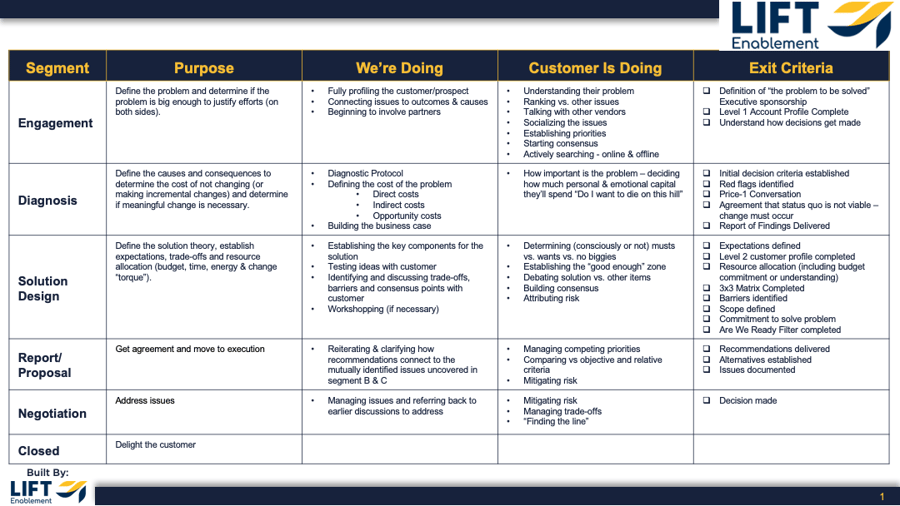
The Role of Sales Playbooks
The question is not, “Do we need a playbook?” The fact is that you have one. A playbook represents the way you do things, and whether your organization’s approach is documented or not, it exists.
So the real question is do you want your playbook to be intentional, purposeful and clear? One that guides actions and innovation? Or do you want one that is haphazard, opaque and that confuses things?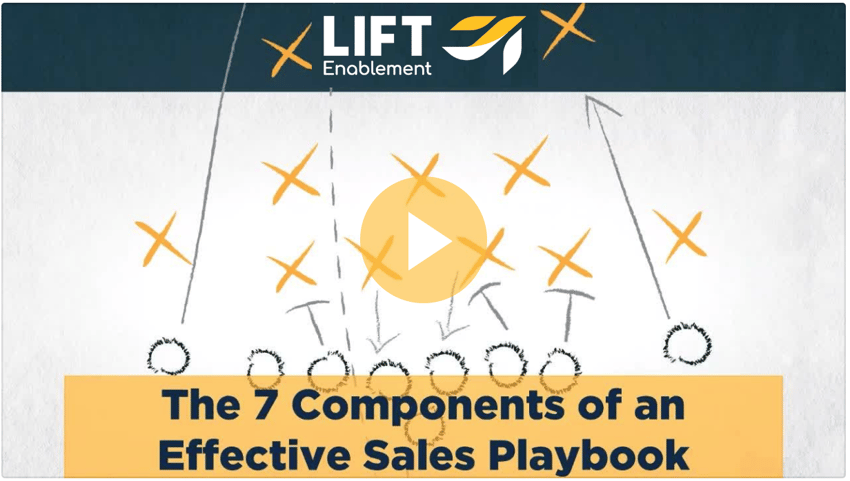 The number one complaint we get from executives and sales reps that pushes back on the concept of playbooks is that playbooks are designed for new reps and are ineffective (or at least unnecessary) for senior reps and teams. Playbooks do not teach reps how to sell, rather they align actions and enable reps to free their attention from a focus on the process to a focus on uncovering important insights about the prospect.
The number one complaint we get from executives and sales reps that pushes back on the concept of playbooks is that playbooks are designed for new reps and are ineffective (or at least unnecessary) for senior reps and teams. Playbooks do not teach reps how to sell, rather they align actions and enable reps to free their attention from a focus on the process to a focus on uncovering important insights about the prospect.
Think of it this way. We’d bet your favorite football player (or artist, dancer, baseball player, etc.) would be pretty damn good at what they did if they just figured things out as they went along. That doesn’t mean they don’t use a playbook. Among truly top performers, playbooks are standard. A playbook enables average performers to perform well, good performers to perform great and great performers to be superstars.
Today, more than ever, playbooks are crucially important. Both sales and marketing processes have multiplied in complexity, and the successful orchestration of complex interactions, involving all parties involved in the customer acquisition process, is continually increasing in importance for successful outcomes.
A strong playbook enables:
- Faster ramp-up and integration of sales reps
- Higher revenue quotas and attainment
- Lower customer acquisition costs
- Shorter sales cycles
- Greater sales velocity
- Quicker learning
- Greater flexibility and agility
Aligning & Integrating Your Sales Process With Your Tech Stack
There is no question that technology has become increasingly important in supporting and enabling the execution of an effective sales process. It’s crucial that a clear strategy guides you as you build your sales tech stack. Over the last 30 years, more money has been invested into sales technology designed to enable salespeople to sell more efficiently and effectively. However, both the time spent selling and the effectiveness of those sales efforts have declined.
The technology you choose should be focused on accelerating the activities associated with your playbook. As you consider and build your sales tech stack, here are the three core categories to focus on:
- CRM: the primary purpose of the CRM is to create a single, objective “source of truth.” The ability to integrate with the rest of your tech stack and to build strong automation and efficiency are the most important factors here.
- Sales Acceleration: These are the tools designed for your sales team. They enable your salespeople to do more, do it faster, do it better and do it all with less effort.
- Sales Tracking & Analytics: These tools enable you to monitor and measure the key actions that are taken.
Time For Action
The biggest challenge to building a strong sales process for most companies is that it feels like an extraordinarily large undertaking, combined with the fear that making such changes will disrupt the existing focus on generating sales and new customers. While this type of undertaking can be big, it does not have to be. Regardless of what approach you take, your objective should be on generating ongoing, continuous improvement.
Here are 3 steps you can take, none of which are difficult or time-consuming to keep making improvements to your sales process:
- Compare your current sales process to customer's journey and align them accordingly.
- Establish at least one exit criteria for each stage in your sales process.
- Every month identify one key area of improvement to bring your sales process into alignment with how your customers really buy.
Of course, if you'd like to dig deeper into identifying ways to improve your sales process to generate more customers with less effort, let us know and we'll be happy to share our experience.

